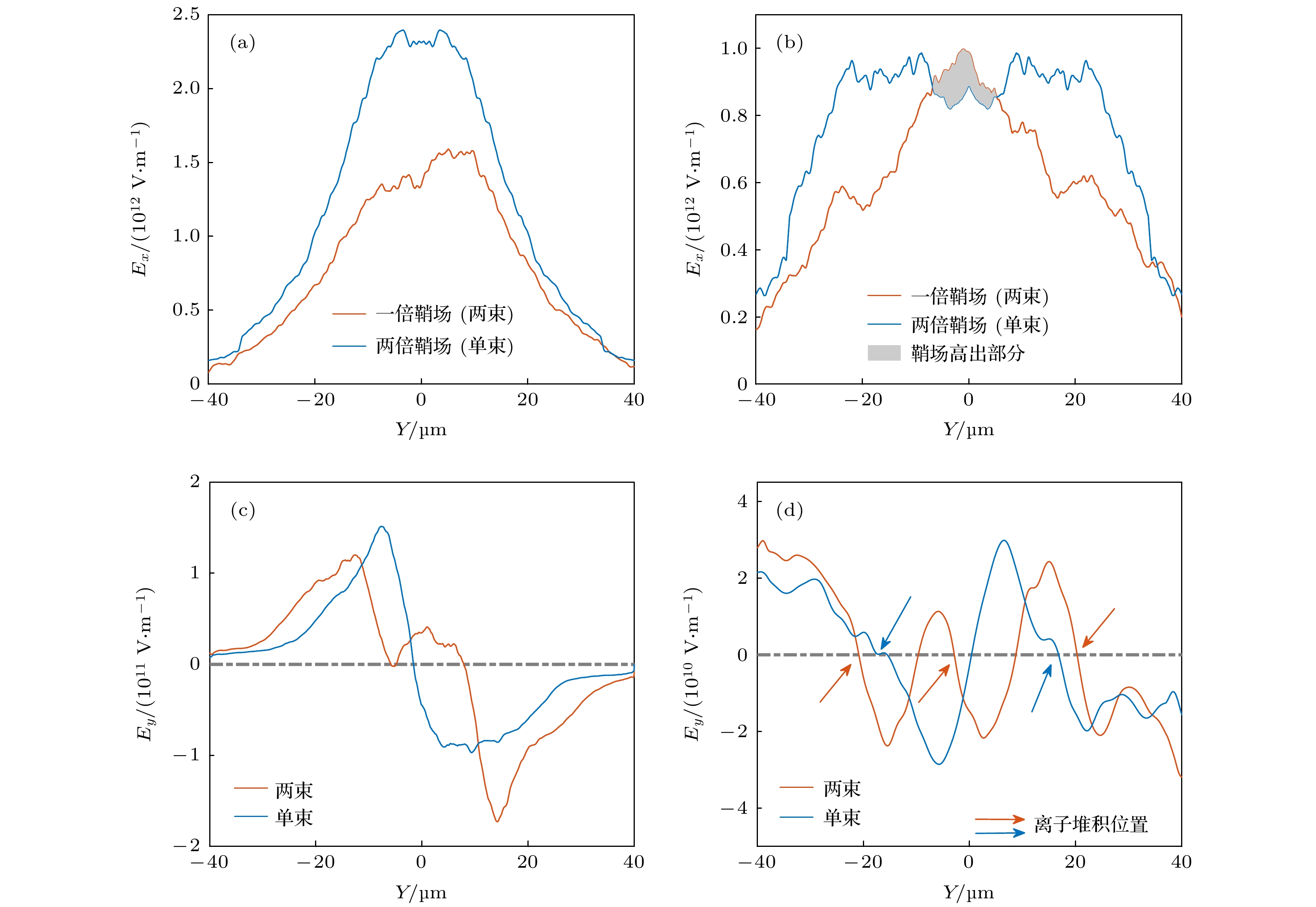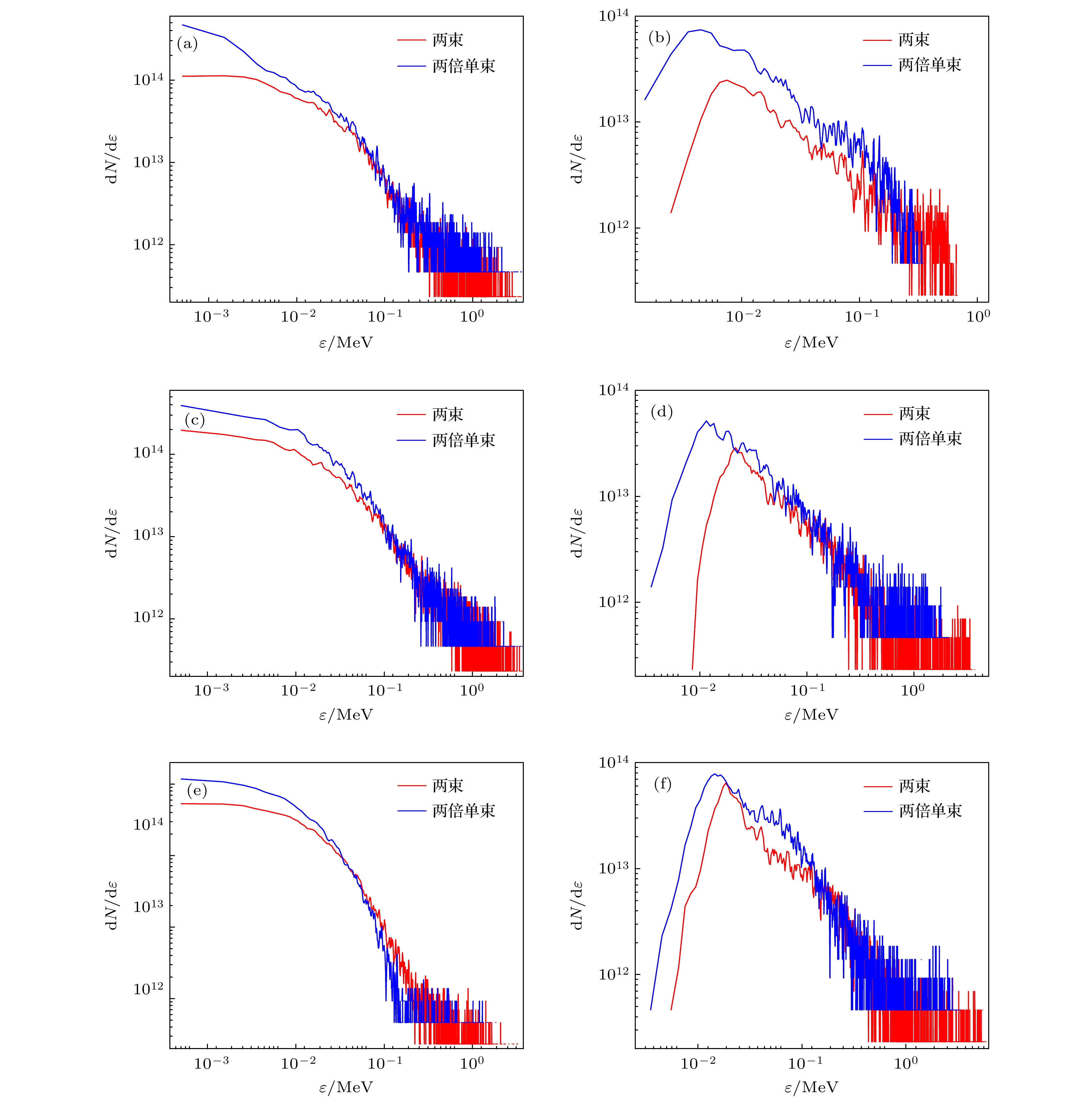-
Recently, the short-pulse intense laser has become a common tool for studying the relativistic plasma with tremendous physical parameters. And the laser-driven magnetic reconnection is one of the hot topics and has received much attention. The laser-driven magnetic reconnection experiments are usually conducted by closely focusing two laser beams on a planar coil target. However, it is always hard to distinguish the physical property of magnetic reconnection from the complex background of laser-produced plasma. In this paper, we present the particle-in-cell simulation results of magnetic reconnection driven by two short-pulse lasers as well as a single laser pulse irradiating the solid planar target, and discuss the correlation between the potential distribution behind the target and the magnetic reconnection. When a single laser is used, the potential behind the target shows a double-peak distribution, which is in agreement with recent experimental results. When two lasers irradiate the target, the potential behind the target shows a three-peak distribution. The accumulated spatial distribution of plasma ions with fixed energy (4.5 and 6 MeV) at 3 μm behind the target shows several peaks, which is in agreement with the potential distribution when either a single laser or two lasers are used. In addition, after the laser pulse terminates, in the two-laser case there is extremely strong effect on the topological structure of the electric field compared with in the singlelaser case. When the magnetic reconnection happens (which can be identified through the reconnection electric field and the electron energy spectrum), the amplitude of the x component of the electric field has different evolution characteristics from the single laser case. The line outs of the y component of the electric field in two cases also have completely different shapes. In summary, the simulation results reveal that the potential distribution behind the target can directly affect the spatial distribution of the accelerated ions. This could be possibly used to identify the short pulse laser-driven magnetic reconnection in experiment.
[1] Mei Z, Shen C, Wu N, Lin J, Murphy N A, Roussev I I 2012 Mon. Not. R. Astron. Soc. 425 2824
 Google Scholar
Google Scholar
[2] Uzdensky D A, Cerutti B, Bgelman M C 2011 Astrophys. J. Lett. 737 L40
 Google Scholar
Google Scholar
[3] Meng Y, Lin J, Zhang L, Reeves K K, Zhang Q S, Yuan F 2014 Astrophys. J. 785 62
 Google Scholar
Google Scholar
[4] Gregory C D, Howe J, Loupias B, Myers S, Notley M M, Sakawa Y, Oya A, Kodama R, Koenig M, Woolsey N C 2008 Astrophys. J. 676 420
[5] Werner G R, Uzdensky D A, Begelman M C, Cerutti B, Nalewajko K 2018 Mon. Not. R. Astron. Soc. 473 4840
 Google Scholar
Google Scholar
[6] Nilson P M, Willingale L, Kaluza M C, et al. 2006 Phys. Rev. Lett. 97 255001
 Google Scholar
Google Scholar
[7] Willingale L, Nilson P M, Kaluza M C, et al. 2010 Phys. Plasmas 17 043104
 Google Scholar
Google Scholar
[8] Ryutov D D, Drake R P, Remington B A 2000 Astrophys. J. Suppl. Ser. 127 465
 Google Scholar
Google Scholar
[9] Zhong J Y, Li Y T, Wang X G, et al. 2010 Nat. Phys. 6 984
 Google Scholar
Google Scholar
[10] Masuda S, Kosugi T, Hara H, Tsuneta S, Ogawara Y 1994 Nature 371 495
 Google Scholar
Google Scholar
[11] Wagner U, Tatarakis M, Gopal A, et al. 2004 Phys. Rev. E 70 026401
 Google Scholar
Google Scholar
[12] Raymond A E, Dong C F, McKelvey A, et al. 2018 Phys. Rev. E 98 043207
 Google Scholar
Google Scholar
[13] Ping Y L, Zhong J Y, Sheng Z M, Wang X G, Liu B, Li Y T, Yan X Q, He X T, Zhang J, Zhao G 2014 Phys. Rev. E 89 031101
 Google Scholar
Google Scholar
[14] Gu Y J, Klimo O, Kumar D, Bulanov S V, Esirkepov T Z, Weber S, Korn G 2015 Phys. Plasmas 22 103113
 Google Scholar
Google Scholar
[15] Guo F, Li H, Daughton W, Liu Y H, 2014 Phys. Rev. Lett. 113 155005
 Google Scholar
Google Scholar
[16] Guo F, Li X, Daughton W, Kilian P, Li H, Liu Y H, Yan W C, Ma D 2019 Astrophys. J. Lett. 879 L23
 Google Scholar
Google Scholar
[17] Kagan D, Sironi L, Cerutti B, Giannios D 2015 Space Sci. Rev. 191 545
 Google Scholar
Google Scholar
[18] Arber T D, Bennett K, Brady C S, et al. 2015 Plasma Phys. Contr. F. 57 113001
 Google Scholar
Google Scholar
[19] Chen M, Shenga Z M, Zheng J, Ma Y Y, Bari M A, Li Y T, Zhang J 2006 Opt. Express 14 3093
 Google Scholar
Google Scholar
[20] Wilks S C, Langdon A B, Cowan T E, et al. 2001 Phys. Plasmas 8 542
 Google Scholar
Google Scholar
[21] Sentoku Y, d’Humières E, Romagnani L, Audebert P, Fuchs J 2011 Phys. Rev. Lett. 107 135005
 Google Scholar
Google Scholar
-
图 4 靶后离子分布的统计结果(灰色针状图)和拟合结果(黄色曲线), 其中X-Y平面的图像是粒子密度(单位经过了临界密度归一化处理); 红色箭头表示激光入射位置 (a) 单束激光模拟中的靶后4.5 MeV离子的分布; (b) 两束激光模拟中的靶后6 MeV离子的分布
Figure 4. Ion distribution at target back from the statistical results (gray needle figure) and the fitting result (yellow curve): (a) 4.5 MeV ion distribution behind the target from simulation of single laser; (b) 6 MeV ion distribution behind the target from simulation of two lasers. Particle number density figure plots on X-Y plane. Laser incident point is marked by red arrows
-
[1] Mei Z, Shen C, Wu N, Lin J, Murphy N A, Roussev I I 2012 Mon. Not. R. Astron. Soc. 425 2824
 Google Scholar
Google Scholar
[2] Uzdensky D A, Cerutti B, Bgelman M C 2011 Astrophys. J. Lett. 737 L40
 Google Scholar
Google Scholar
[3] Meng Y, Lin J, Zhang L, Reeves K K, Zhang Q S, Yuan F 2014 Astrophys. J. 785 62
 Google Scholar
Google Scholar
[4] Gregory C D, Howe J, Loupias B, Myers S, Notley M M, Sakawa Y, Oya A, Kodama R, Koenig M, Woolsey N C 2008 Astrophys. J. 676 420
[5] Werner G R, Uzdensky D A, Begelman M C, Cerutti B, Nalewajko K 2018 Mon. Not. R. Astron. Soc. 473 4840
 Google Scholar
Google Scholar
[6] Nilson P M, Willingale L, Kaluza M C, et al. 2006 Phys. Rev. Lett. 97 255001
 Google Scholar
Google Scholar
[7] Willingale L, Nilson P M, Kaluza M C, et al. 2010 Phys. Plasmas 17 043104
 Google Scholar
Google Scholar
[8] Ryutov D D, Drake R P, Remington B A 2000 Astrophys. J. Suppl. Ser. 127 465
 Google Scholar
Google Scholar
[9] Zhong J Y, Li Y T, Wang X G, et al. 2010 Nat. Phys. 6 984
 Google Scholar
Google Scholar
[10] Masuda S, Kosugi T, Hara H, Tsuneta S, Ogawara Y 1994 Nature 371 495
 Google Scholar
Google Scholar
[11] Wagner U, Tatarakis M, Gopal A, et al. 2004 Phys. Rev. E 70 026401
 Google Scholar
Google Scholar
[12] Raymond A E, Dong C F, McKelvey A, et al. 2018 Phys. Rev. E 98 043207
 Google Scholar
Google Scholar
[13] Ping Y L, Zhong J Y, Sheng Z M, Wang X G, Liu B, Li Y T, Yan X Q, He X T, Zhang J, Zhao G 2014 Phys. Rev. E 89 031101
 Google Scholar
Google Scholar
[14] Gu Y J, Klimo O, Kumar D, Bulanov S V, Esirkepov T Z, Weber S, Korn G 2015 Phys. Plasmas 22 103113
 Google Scholar
Google Scholar
[15] Guo F, Li H, Daughton W, Liu Y H, 2014 Phys. Rev. Lett. 113 155005
 Google Scholar
Google Scholar
[16] Guo F, Li X, Daughton W, Kilian P, Li H, Liu Y H, Yan W C, Ma D 2019 Astrophys. J. Lett. 879 L23
 Google Scholar
Google Scholar
[17] Kagan D, Sironi L, Cerutti B, Giannios D 2015 Space Sci. Rev. 191 545
 Google Scholar
Google Scholar
[18] Arber T D, Bennett K, Brady C S, et al. 2015 Plasma Phys. Contr. F. 57 113001
 Google Scholar
Google Scholar
[19] Chen M, Shenga Z M, Zheng J, Ma Y Y, Bari M A, Li Y T, Zhang J 2006 Opt. Express 14 3093
 Google Scholar
Google Scholar
[20] Wilks S C, Langdon A B, Cowan T E, et al. 2001 Phys. Plasmas 8 542
 Google Scholar
Google Scholar
[21] Sentoku Y, d’Humières E, Romagnani L, Audebert P, Fuchs J 2011 Phys. Rev. Lett. 107 135005
 Google Scholar
Google Scholar
Catalog
Metrics
- Abstract views: 5824
- PDF Downloads: 72
- Cited By: 0















 DownLoad:
DownLoad:






